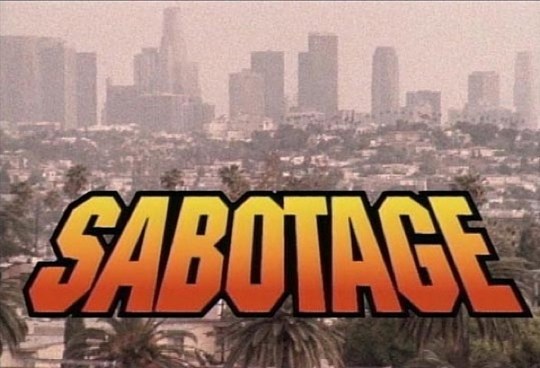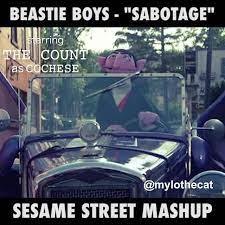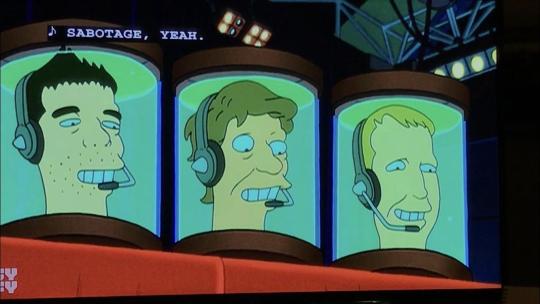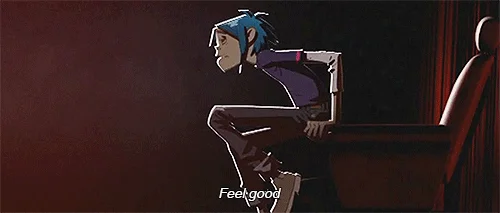Don't wanna be here? Send us removal request.
Text
Discussion Leader Presentation
SABOTAGE - BEASTIE BOYS (JAN 1994)

The Beastie Boys song Sabotage and music video was released in 1994. It was filmed throughout L.A. in Los Feliz, Echo Park, Silverlake, Hollywood, and Downtown Los Angeles. The message of this song is considered to be “anti-authority”. Although not revealed until 2020 in their documentary, the inspiration behind Sabotage was their former producer whom they felt was constantly "sabotaging" them. This song and music video has been reproduced in many formats. Different versions have been made, it has been featured in TV shows and movies (such as Futurama and an advertisement for Minions: the Rise of Gru), and performed on Saturday Night Live. In 2020, it was used as background music for a Biden campaign ad, criticising Trump's COVID response and featuring Biden wearing black shades jogging up into a plane.


Our readings have introduced different perspectives on mass culture: the disappearance of the aura in Walter Benjamin's essay, how the culture industry functions within existing power structures in Horkheimer and Adorno’s essay, and how messages are created and received in Hall’s essay.
Considering these perspectives, the mass production and popularity of the music video for Sabotage by Beastie Boys reveals how the culture industry elevates and thrives off pieces which have vague and digestible meanings.
Sabotage in particular demonstrates the lack of autonomy a piece has after becoming a part of culture. Rather than having a clear intention or message, this song and music video seems to use vague emotional appeals, humour, and action to catch people's attention. The storyline is hard to follow, but it is reminiscent of crime dramas, except there's no distinction between "good" guys or "bad" guys. It shows authority figures causing chaos rather than fulfilling their supposed role. The appearance and behaviour of the policemen characters are exaggerated and silly. They're wearing fake moustaches, fake mullets, and sunglasses and are shown doing ridiculous and unnecessary things like jumping from building to building, spontaneously somersaulting, and eating donuts. This has the effect of making fun of policemen.

I wonder if there's a connection between the "anti-authority" interpretation and the L.A. Riots following the videotaped beating of Rodney King. Despite the proximity, the video doesn't seem to directly address this.
Regardless, the way it was received by the audience as “anti-authority” doesn’t take precedence over the way the culture industry functions, which is to produce copies and further profit off of the popularity of the song and music video. Through this process, the piece’s supposed “anti-authority” message gets distorted and weakened.
Taking from Walter Benjamin, its video format “substitutes a plurality of copies for a unique existence” (1236). The audience is separated from the context in which it was filmed. Taken out of context, the purposiveness of the piece is lost as it occupies new settings and may be interpreted completely differently. Because it is produced with this intention of mass consumption, which thrives off emotional appeal and relatability, the purpose or message gets somewhat diluted. According to Walter Benjamin, "it begins to be based on another practice - politics” (1237). This brings me back to the Biden campaign ad which uses this song with a supposed "anti-authority" reputation to criticise Trump (linked below 0:07 - 1:07).
youtube
According to Horkheimer and Adorno, the logic of a work is congruous with that of the social system (1242). In this case, while the Sabotage video might be considered anti-authority for its utter chaos and destruction, it doesn't specifically critique authority or demand an action. Rather, it seems like a crime drama parody, and it affirms what we already think. The theme of “anti-authority” may make people feel empowered, but this is similar to the aestheticization of war. It glorifies this catharsis of emotion that justifies the social system and power structures in place.
“The greater the decrease in the social significance of an art form, the sharper the distinction between criticism and enjoyment by the public. The conventional is uncritically enjoyed, and the truly new is criticized with aversion.” (Horkheimer and Adorno 1237)
FEEL GOOD - GORILLAZ (MAY 2005)

This is a very popular song by the Gorillaz, and it offers a critique of culture by depicting how consumers are numbed out on "good" emotions and trapped inside this system that exists to profit off of musicians and consumers. Ironically, this song also hit No. 2 in the U.K. and No. 14 in the U.S., so its success depends very system that it criticises.

Above is a moving image of the character 2D, using a megaphone to try to get people to listen. He says,
City's breaking down on a camel's back They just have to go, 'cause they don't know wack So while you fill the streets, it's appealing to see You won't get out the county, 'cause you're bad and free
You got a new horizon, it's ephemeral style A melancholy town where we never smile And all I wanna hear is the message beep My dreams, they got a kissing 'Cause I don't get sleep, no
The lyrics are hard to understand on their own, but paired with the visual of 2D walking over all these people lying on the ground, not paying attention to him, it becomes clear that he's trying to get a message out, but no one is listening. The words he speaks into the microphone become thin air, and everyone is too numb to hear him.

He then looks out the window and sees Noodle floating on an island peacefully playing music. Birds are chirping in the background, and during this part of the song, the sound and voice changes creating a more peaceful and faraway feeling. However, in the video, you can see that there are helicopters chasing Noodle down, suggesting that she will inevitably get trapped in the culture industry. This reminds me of a quote from Horkheimer and Adorno: "Talented performers belong to the industry long before it displays them; otherwise they would not be so eager to fit in" (1243).
The reading and the music video suggest the inevitability that the forces of the culture industry are too strong to be resisted, and any talent will be pulled into its orbit and pushed through its system to the masses.

Throughout the music video 2D seems stuck and anxious to find a way to escape and get other people to hear what he's saying. When De La Soul comes on speaking on the big screens, 2D looks up frightened and seems to feel cornered into becoming part of the system although he doesn't want to. There's a lyric sung by De La Soul that goes,
Gon' bite the dust, can't fight with us With yo' sound, you kill the Inc
So don't stop, get it, get it (get it) Until you're cheddar headed
It demonstrates the feeling of pressure on 2D to keep going, and De La Soul is convincing him that his song with this message can "kill the Inc".
What I find interesting about this song is that while it is a critique of the music industry and mass culture, because it functions within that very system, its message may be overlooked. Horkheimer and Adorno say that culture has an "economic mechanism of selection... there is the agreement - or at least the determination - of all executive authorities not to produce or sanction anything that in any way differs from their own rules, their own ideas about consumers, or above all themselves" (1244). Despite its critique of the system, this song still abides to the rules of the culture industry, in the way that it has been produced and received by the public. Producers are aware of this, so producing a song that critiques the music industry doesn't worry them because it doesn't change the power structures. In this instance, the song became very popular. This reminds me of a quote from Walter Benjamin:
"Its self-alienation has reached such a degree that it can experience its own destruction as an aesthetic pleasure of the first order." (1210)
This song is a good example of this because it was created with a message that reflects a feeling of alienation, yet it is an upbeat song meant to make us "feel good" and succeeds at that. Without analysing it, the meaning can go completely overlooked. Like Hall says, "if the meaning is not articulated in practice, it has no effect" (508).

Questions for analysis:
How does the transferability of media to different platforms and contexts enhance or dilute the meaningfulness/impact of a piece?
In both music videos, to what extent does the author's intention have authority over the meaning and significance of the piece?
Do you think the culture industry is always self-reinforcing, or are there areas of contradiction where multiple forces are at play? How do these potential areas of contradiction shape or change the way the culture industry functions?
3 notes
·
View notes
Text
song: coton ouaté - bleu jeans bleu
6 notes
·
View notes